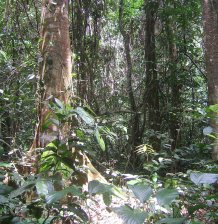
Tropical forests play a key role in storing carbon
Small trees are among the oldest in Congolese rainforest
Forest giants have long been considered the oldest trees in tropical forests, but new research shows small trees can also be very old, and can even grow older than the big ones.
Scientists associated with the Royal Museum for Central Africa published this finding in the journal Nature Plants.
The discovery that small trees can live longer, and therefore hold on to longer-term carbon, has important consequences for forest policy in the tropics.
Scientists from an international consortium including the University of Exeter, the RMCA, Ghent University and the Congolese Institute for Agricultural Research made the surprising conclusion that some small trees in the Luki reserve, in the southwest of Congo, are much older than they look.
They hardly appear to grow and almost stand still in time.
“We found that a tree with a diameter of 10cm can easily be 300 years old, while trees ten times larger may be half the age,” said forest ecologist Bhély Angoboy Ilondea, of the RMCA.
To study the growth rate of the trees, the scientists measured growth ring widths on wood samples taken with a hollow drill.
A unique aspect is that the growth speed of the trees could be measured with great precision, thanks to the metal identification tags that colonial scientists attached to some 6,000 trees in the reserve 70 years ago.
The scars that were left by the nails used for tagging precisely indicate the year 1948.
Until recently, the Luki research area had been “forgotten”. Armed with a “treasure map” from the colonial period and with a metal detector, the RMCA research team tracked the tags and nails that sometimes grew up to 20 cm deep in the wood.
It became clear that many small trees grow at an extremely slow pace, and that they can therefore reach a very old age.
Dr Ted Feldpausch, a tropical forest ecologist in Geography at the University of Exeter, and one of the co-authors on the study, said: “In tropical forests, it is often the towering emergents from the top of the forest canopy that receive the most attention – they are iconic and can be massive, taking up and storing large amounts of carbon from the atmosphere.
“Our study from old-growth forests in Africa shows that big is not all that counts when looking at carbon sequestration and the age of the carbon in trees; the smallest stems in the forest understory can be as old as the giants and hold an important and disproportionately large role for their size in the forest carbon sink.
“This highlights that although being left in the shade, these small trees should not be neglected from the research spotlight to better understand their critical role in the tropical forest carbon cycle, where the oldest trees and oldest carbon storage in the forest are not always in the largest trees.
“While the trees are small, they are abundant, and when you add up the carbon they contain and see it persists over very long life-spans, these little trees can have a big impact on forest carbon.
“Understanding the role of these small trees is also urgent considering that many tropical forests have undergone an increase in drought, fire and logging over recent decades.
“Rather than focus on how these changes affect the largest trees, we also need to consider impacts on these small but essential understory trees.”
The unique data from the Congolese rainforest were compared with “classic” growth measurements (diameter measurements) from the African Tropical Rainforest Observation Network (www.afritron.org led by the University of Leeds) of tens of thousands of trees from across four Central African countries. This confirmed the new insights in how trees grow and how old they grow.
The new AfricaMuseum opened its doors on 9 December 2018. Sustainable forestry in Central Africa is illustrated in the zones dealing with biodiversity and the "resource paradox".
The RMCA manages the world’s most important collection of African wood samples, with more than 80,000 specimens belonging to 13,000 different species.
This collection is the result of more than 100 years of fieldwork and offers unique study material for a wide series of contemporary projects focused on forest conservation, responsible management and sustainability.
Date: 21 January 2019
